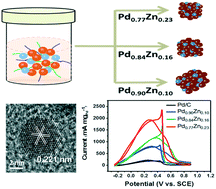Pd–Zn nanocrystals for highly efficient formic acid oxidation†
Abstract
Highly uniform and compositionally graded Pd–Zn nanocrystals (NCs) with particle diameters of approximately 5.0–6.5 nm are obtained via a facile one-pot synthesis process in dimethylformamide (DMF) and water solution. The Pd–Zn NCs are formed by the reduction of transition metal ions coexisting in ascorbic acid (AA) and noble metals. The NCs are characterized by X-ray diffraction, X-ray photoelectron spectroscopy and transmission electron microscopy. Investigations indicated that the NCs have compositionally graded PdxZn1−x NCs with x ranging from 0.68 to 1.00. Electrochemical measurements reveal that the PdxZn1−x NCs exhibit superior electrocatalytic performance of both activity and stability for the formic acid oxidation (FAO) reaction compared with commercial Pd/C. The optimized Pd0.77Zn0.23 NCs exhibit a FAO catalytic oxidation current density of 1945 mA mgPd−1, which is 8.2 times higher than that of commercial Pd/C (237 mA mgPd−1). CO stripping measurement indicates that the tolerance to CO poisoning has been significantly improved by alloying Zn. The excellent performance can be attributed to the synergistic effect between Pd and Zn in Pd–Zn NCs.



 Please wait while we load your content...
Please wait while we load your content...